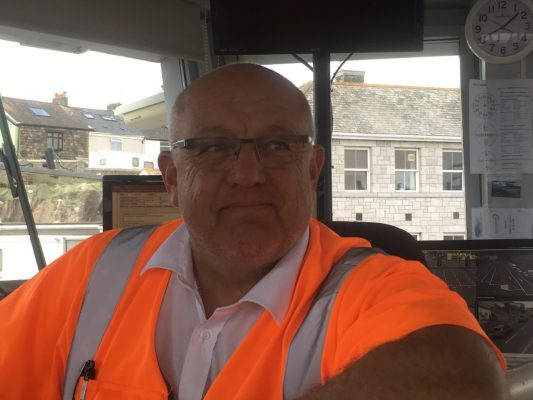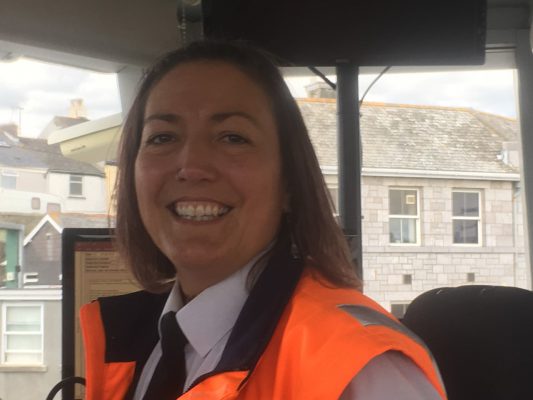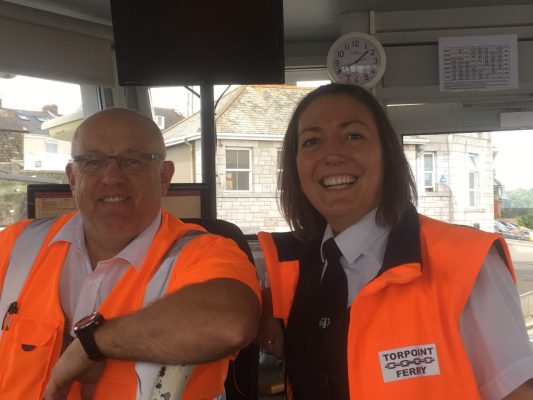Meet Mike and Claudine who oversee the day to day operation of the Torpoint ferries
Regular users of the Torpoint ferries will know many of the staff who collect the tolls and drive the vessels across the river. However there is one group they may not be so familiar with – the supervisors who are responsible for overseeing the safe and effective day to day operation of the three ferries.
In 1791 a privately owned operation with vessels powered by oars and sail was established to cross the Tamar. The first chain ferry service linking Torpoint and Devonport started operating in 1834, and several generations of ferry later the current vehicle and pedestrian chain ferry continue to service the route. The three ferries – Tamar II, Lynher II and Plym II – are the largest chain ferries in the world and provide a service 24 hrs a day, 365 days a year, with a 10 minute frequency at peak times. The crossing is the busiest estuarial vehicular ferry crossing in the country, with the three vessels carrying nearly two and a half million vehicles and up approximately 750 thousand foot passengers each year
A team of nine supervisors, based in the control towers at Devonport and Torpoint, are responsible for managing the day to day provision of service delivery . This means keeping a close eye on everything that is going on to make sure that it is being done safely whilst keeping the service running, as well as directing the loading of vehicles onto the ferries and managing the crews operating the vessels. They also liaise between the emergency services and the ferry crews.
Mike Bright joined the ferry service 15 years ago as a yard operative (or as they called it bilge rat) and has now worked his way up to his ‘dream job’ as a supervisor. Now aged 51, Mike, who has lived all his life in Torpoint, is very proud of his role and knows how important this service is to the local people, businesses and economy of the Rame peninsular and surrounding area.
“I had always wanted to work on the ferries and spent 20 years trying to get a job here” he said. “My first job was a yard operative which involved cleaning and mopping out water from the bilges of the ferries. After spending some time doing this role, the introduction of four man crews provided an opportunity to become a collector.”

Having worked as a collector for four years Mike successfully applied for a part time supervisor’s role at Devonport which was advertised on a six months trial basis. This led to a position as a relief supervisor, which then turned into a full time supervisor’s role seven years ago.
Claudine Jones took a very different route to becoming a ferry supervisor. Having worked for a number of years as a VAT Inspector, she lost her job when HRMC closed the Plymouth Tax Office three years ago. While her colleagues were applying for jobs in accountancy firms or other administrative roles, she decided that she was “not an office kind of girl” and wanted to do something different with her life.
“The ferry service were advertising for an assistant supervisor and I decided to apply for the job“ she said. “Luckily I got an interview and was offered the job”

Claudine became a supervisor earlier this year and, like Mike, says that this is her dream job. “I love working here“ she said. “The team are fantastic and I love working next to the river. There is always something different to see – from boats, ducks, herons and dolphins, to the most incredible rainbows over the river. “
Both Mike and Claudine work a nine week shift pattern, rotating between 6 am and 2 pm, and 2 pm and 10 pm, based either at the Devonport or Torpoint control towers. All supervisors manage a team of six members of staff, including a controller, two collectors, a mechanical assistant and two ferry crew reliefs.
A key element of the role is to manage the traffic using the ferries. “Each ferry can accommodate a maximum of 73 vehicles (depending on the size) and our job is to make sure that these vehicles are loaded onto the vessels as safely and efficiently as possible “ said Mike . “The vehicles need to be loaded in a managed way to ensure that the ferry is safe, and we have to shut the barriers when the ferry is full.
“We monitor the seven lanes of traffic in Torpoint and eleven lanes in Devonport using CCTV, and manage the traffic flows to keep the queues moving as quickly as possible.”

While most drivers abide by the rules and wait patiently for their turn to board the ferries, the supervisors sometimes have to deal with a small number of drivers who either fail to see the traffic lights on the lanes, or who deliberately use the wrong lane to try and get to the front of a queue. Accidents on roads into the town, or a reduction in the number of ferries because of severe weather or mechanical problems, can cause congestion and delays which can, in turn, lead to challenging situations for the supervisors.
“I have had people jumping out of their cars and banging the door to the control tower but you learn not to take it personally “ said Mike. “Some people can get angry but most understand that we are all doing our best to get traffic on the ferry and across the river as quickly and safely as possible “ added Claudine.
Another important task for the supervisors is to liaise with the blue light services to ensure that crews dealing with an emergency situation can cross the river as quickly as possible. “Usually we get a call from the police, fire or ambulance service saying they are dealing with an emergency and will be arriving in about 10 minutes“ said Mike .
“In these cases we can either hold a departing ferry until they arrive or let the ferry leave earlier than scheduled. This can take place during the day or at night and is one of the reasons we operate a 24 hour service across the river. Travelling by ferry rather than driving on land via the Tamar Bridge can save around 40 minutes which could be vital in a life threatening situation.”
“We also have calls from members of the public who need to get across the river in an emergency “ added Claudine. “This could be someone whose partner is in labour and needs to get to hospital quickly or an individual who has had an accident. In these cases we do all we can to help”.
While the supervisors’ role includes a number of routine tasks, one of the things both Claudine and Mike love about there is that no two days are the same. “There are so many different parts of the job that you are always keeping lots of balls in the air “ said Claudine.
The location of the ferry slipways, exposed moving chains, approaching vessels, water and continuous traffic, means that the supervisors have to follow a complex set of safety policies and procedures. “We have to keep people back from the water’s edge or the approaching ferry prow “ she explained. “We also have to ensure that the traffic does not leave the vessel until all the foot passengers have got off and are in a safe place, and look out for and help vulnerable people when required. This could mean offering first aid or providing emergency help.
“We liaise with Flag Port Control to help manage the safe passage of all river traffic around the ferries, looking out for vulnerable vessels or wildlife on the river (kayaks yachts swans! ) “ added Mike. We also work with ferry and maintenance staff to ensure any works carried out outside the yard are done safely and effectively.
“Whether you are sending traffic to the ferry, answering a query from a controller or customer, dealing with a breakdown on the ferry, or responding to a call from one of the blue light services – there is always something happening” said Claudine. “Add the amazing camaraderie from the team and the beautiful river setting and I cannot imagine anyone wanting to work anywhere else. “
